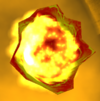Wormhole: Difference between revisions
No edit summary |
(Restored) |
||
| Line 1: | Line 1: | ||
[[File:WormholeNetwork.png|thumb|right|Interstellar wormhole network.]] | [[File:WormholeNetwork.png|thumb|right|Interstellar wormhole network.]] | ||
'''Wormholes''' are portals that connect solar systems and galaxies. Spacecraft can utilize them to instantly travel between solar systems. | |||
Interstellar wormholes interconnect [[Solar_System|solar system]]s in a loose branching network. Almost every solar system has one or more interstellar wormholes near the primary [[sun]]. Not all solar systems are interconnected by wormholes. Wormholes create disjoint islands of interconnected solar systems. | ''Interstellar wormholes'' interconnect [[Solar_System|solar system]]s in a loose branching network. Almost every solar system has one or more interstellar wormholes near the primary [[sun]]. Not all solar systems are interconnected by wormholes. Wormholes can create disjoint islands of interconnected solar systems. | ||
Intergalactic wormholes interconnect [[Galaxy|galaxies]] in a loose branching network. Every galaxy has one or more intergalactic wormholes around the [[Supermassive_Black_Hole|supermassive black hole]] at their core. All galaxies are interconnected by wormholes. | ''Intergalactic wormholes'' interconnect [[Galaxy|galaxies]] in a loose branching network. Every galaxy has one or more intergalactic wormholes around the [[Supermassive_Black_Hole|supermassive black hole]] at their core. All galaxies are interconnected by wormholes. Smaller [[Black_Hole_(Celestial)|celestial black holes]] found in random solar systems can also have one or more intergalactic wormholes around them. | ||
[[Starship]]s use [[Wormhole_Drive|wormhole drive]]s to travel instantly from one solar system to another through interstellar wormholes. Starships also use wormhole drives to travel instantly from one galaxy to another through intergalactic wormholes. | [[Starship]]s use [[Wormhole_Drive|wormhole drive]]s to travel instantly from one solar system to another through interstellar wormholes. Starships also use wormhole drives to travel instantly from one galaxy to another through intergalactic wormholes. | ||
[[Ringworld#Star_Gate|Star gate]]s create a temporary wormhole to a destination solar system from which a [[preon]] was harvested. The destination system of a star gate could even be another galaxy, | [[Ringworld#Star_Gate|Star gate]]s create a temporary wormhole to a destination solar system from which a [[preon]] was harvested. The destination system of a star gate could even be in another galaxy, which of course require that the preon is from a star in that galaxy. | ||
{| | {| | ||
| Line 20: | Line 19: | ||
==Obstructed Wormholes== | ==Obstructed Wormholes== | ||
A wormhole can become obstructed by a celestial body that orbits across it. If a spacecraft | A wormhole can become obstructed by a celestial body that orbits across it. If a spacecraft emerges from a wormhole like that, the spacecraft is placed farther away from the destination sun until it doesn't hit anything. | ||
The crew will not attempt to enter a wormhole that is obstructed by a celestial body. | The crew will not attempt to enter a wormhole that is obstructed by a celestial body. | ||
==Wormhole Pairs== | ==Wormhole Pairs== | ||
Most wormholes exist in pairs, either between two [[Solar_System|solar system]]s or two [[galaxies]]. The wormholes always point towards their other pair through the celestial host. | |||
However, intergalactic wormholes found around [[Black_Hole_(Celestial)|celestial black holes]] are one-way, and do not provide a return path on the other side. | |||
===Polarity=== | ===Polarity=== | ||
Each end of an interstellar | Each end of an interstellar wormhole has its own polarity, one end of the wormhole will have a positive polarity, the other end of the wormhole will have a negative polarity. It is possible that two wormhole pairs exist between two solar systems, in this case the polarity of each pair is always opposite of the other. | ||
Intergalactic wormholes are always neutral. | Intergalactic wormholes are '''always''' neutral. | ||
The polarity of a wormhole can be identified by its color: | The polarity of a wormhole can be identified by its color: | ||
| Line 40: | Line 41: | ||
There are three types of wormholes: | There are three types of wormholes: | ||
* Natural '''interstellar''' wormholes that are present around a [[Solar_System|solar system]]'s primary sun. | * Natural '''interstellar''' wormholes that are present around a [[Solar_System|solar system]]'s primary sun. | ||
* Natural '''intergalactic''' wormholes that are present around | * Natural '''intergalactic''' wormholes that are present around [[Supermassive_Black_Hole|supermassive black holes]] and [[Black_Hole_(Celestial)|celestial black holes]]. | ||
* Temporary '''artificial''' wormholes are created by a [[Ringworld#Star_Gate|star gate]]. | * Temporary '''artificial''' wormholes are created by a [[Ringworld#Star_Gate|star gate]]. | ||
[[Category:Science]] | [[Category:Science]] | ||
Revision as of 08:31, 10 March 2024

Wormholes are portals that connect solar systems and galaxies. Spacecraft can utilize them to instantly travel between solar systems.
Interstellar wormholes interconnect solar systems in a loose branching network. Almost every solar system has one or more interstellar wormholes near the primary sun. Not all solar systems are interconnected by wormholes. Wormholes can create disjoint islands of interconnected solar systems.
Intergalactic wormholes interconnect galaxies in a loose branching network. Every galaxy has one or more intergalactic wormholes around the supermassive black hole at their core. All galaxies are interconnected by wormholes. Smaller celestial black holes found in random solar systems can also have one or more intergalactic wormholes around them.
Starships use wormhole drives to travel instantly from one solar system to another through interstellar wormholes. Starships also use wormhole drives to travel instantly from one galaxy to another through intergalactic wormholes.
Star gates create a temporary wormhole to a destination solar system from which a preon was harvested. The destination system of a star gate could even be in another galaxy, which of course require that the preon is from a star in that galaxy.
 |
 |
 |
 |
 |
Obstructed Wormholes
A wormhole can become obstructed by a celestial body that orbits across it. If a spacecraft emerges from a wormhole like that, the spacecraft is placed farther away from the destination sun until it doesn't hit anything.
The crew will not attempt to enter a wormhole that is obstructed by a celestial body.
Wormhole Pairs
Most wormholes exist in pairs, either between two solar systems or two galaxies. The wormholes always point towards their other pair through the celestial host.
However, intergalactic wormholes found around celestial black holes are one-way, and do not provide a return path on the other side.
Polarity
Each end of an interstellar wormhole has its own polarity, one end of the wormhole will have a positive polarity, the other end of the wormhole will have a negative polarity. It is possible that two wormhole pairs exist between two solar systems, in this case the polarity of each pair is always opposite of the other.
Intergalactic wormholes are always neutral.
The polarity of a wormhole can be identified by its color:
- Positive wormholes are identified by blue, cyan and white colors.
- Negative wormholes are identified by red, yellow and white colors.
- Neutral wormholes are identified by blue and magenta colors.
Wormhole Types
There are three types of wormholes:
- Natural interstellar wormholes that are present around a solar system's primary sun.
- Natural intergalactic wormholes that are present around supermassive black holes and celestial black holes.
- Temporary artificial wormholes are created by a star gate.